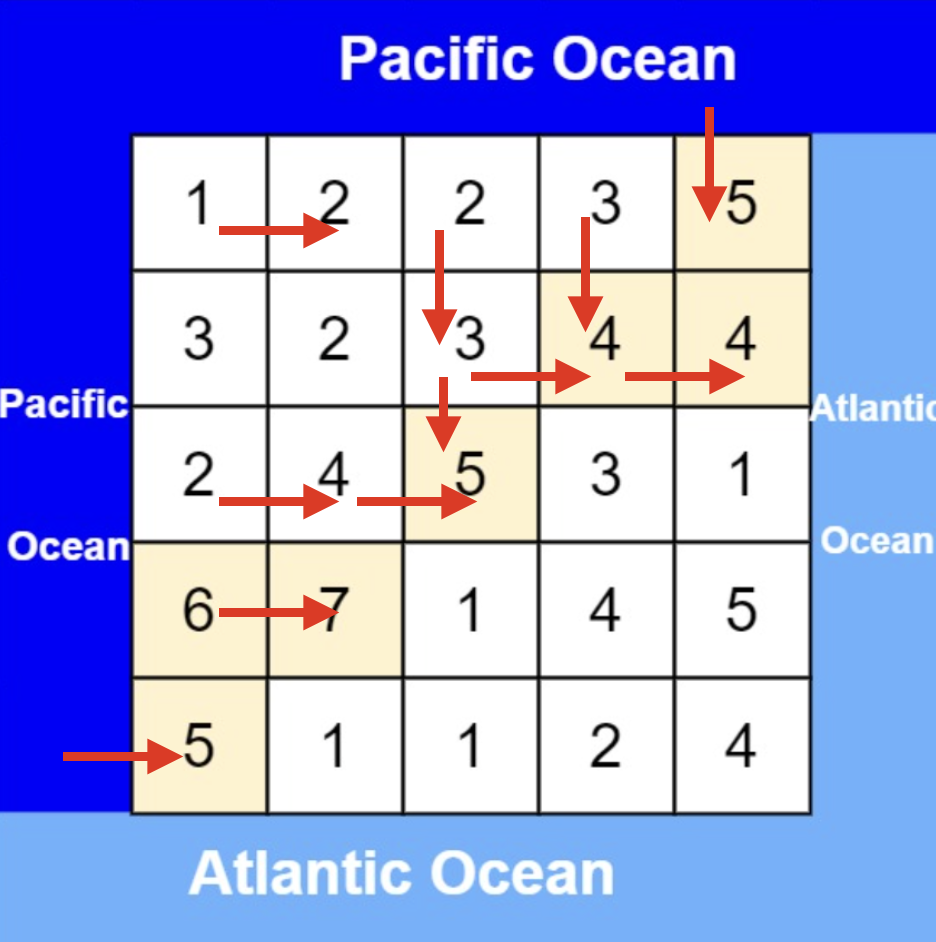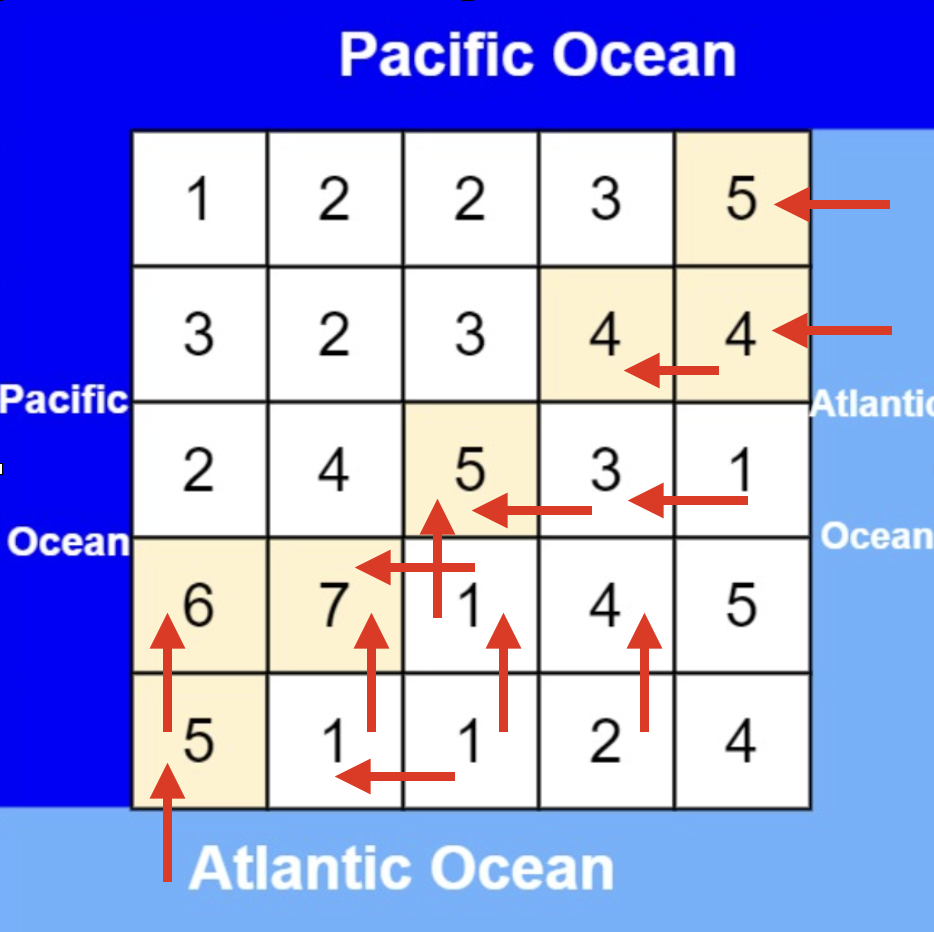8.3 KiB
参与本项目,贡献其他语言版本的代码,拥抱开源,让更多学习算法的小伙伴们收益!
# 417. 太平洋大西洋水流问题思路
不少同学可能被这道题的题目描述迷惑了,其实就是找到哪些点 可以同时到达太平洋和大西洋。 流动的方式只能从高往低流。
那么一个比较直白的想法,其实就是 遍历每个点,然后看这个点 能不能同时到达太平洋和大西洋。
至于遍历方式,可以用dfs,也可以用bfs,以下用dfs来举例。
那么这种思路的实现代码如下:
class Solution {
private:
int dir[4][2] = {-1, 0, 0, -1, 1, 0, 0, 1};
void dfs(vector<vector<int>>& heights, vector<vector<bool>>& visited, int x, int y) {
if (visited[x][y]) return;
visited[x][y] = true;
for (int i = 0; i < 4; i++) {
int nextx = x + dir[i][0];
int nexty = y + dir[i][1];
if (nextx < 0 || nextx >= heights.size() || nexty < 0 || nexty >= heights[0].size()) continue;
if (heights[x][y] < heights[nextx][nexty]) continue; // 高度不合适
dfs (heights, visited, nextx, nexty);
}
return;
}
bool isResult(vector<vector<int>>& heights, int x, int y) {
vector<vector<bool>> visited = vector<vector<bool>>(heights.size(), vector<bool>(heights[0].size(), false));
// 深搜,将x,y出发 能到的节点都标记上。
dfs(heights, visited, x, y);
bool isPacific = false;
bool isAtlantic = false;
// 以下就是判断x,y出发,是否到达太平洋和大西洋
for (int j = 0; j < heights[0].size(); j++) {
if (visited[0][j]) {
isPacific = true;
break;
}
}
for (int i = 0; i < heights.size(); i++) {
if (visited[i][0]) {
isPacific = true;
break;
}
}
for (int j = 0; j < heights[0].size(); j++) {
if (visited[heights.size() - 1][j]) {
isAtlantic = true;
break;
}
}
for (int i = 0; i < heights.size(); i++) {
if (visited[i][heights[0].size() - 1]) {
isAtlantic = true;
break;
}
}
if (isAtlantic && isPacific) return true;
return false;
}
public:
vector<vector<int>> pacificAtlantic(vector<vector<int>>& heights) {
vector<vector<int>> result;
// 遍历每一个点,看是否能同时到达太平洋和大西洋
for (int i = 0; i < heights.size(); i++) {
for (int j = 0; j < heights[0].size(); j++) {
if (isResult(heights, i, j)) result.push_back({i, j});
}
}
return result;
}
};
这种思路很直白,但很明显,以上代码超时了。 来看看时间复杂度。
遍历每一个节点,是 m * n,遍历每一个节点的时候,都要做深搜,深搜的时间复杂度是: m * n
那么整体时间复杂度 就是 O(m^2 * n^2) ,这是一个四次方的时间复杂度。
优化
那么我们可以 反过来想,从太平洋边上的节点 逆流而上,将遍历过的节点都标记上。 从大西洋的边上节点 逆流而长,讲遍历过的节点也标记上。
从太平洋边上节点出发,如图:
从大西洋边上节点出发,如图:
按照这样的逻辑,就可以写出如下遍历代码:(详细注释)
(如果对dfs基础内容就不懂,建议看 「代码随想录」DFS算法精讲!,还可以顺便解决 797. 所有可能的路径)
class Solution {
private:
int dir[4][2] = {-1, 0, 0, -1, 1, 0, 0, 1}; // 保存四个方向
// 从低向高遍历,注意这里visited是引用,即可以改变传入的pacific和atlantic的值
void dfs(vector<vector<int>>& heights, vector<vector<bool>>& visited, int x, int y) {
if (visited[x][y]) return;
visited[x][y] = true;
for (int i = 0; i < 4; i++) { // 向四个方向遍历
int nextx = x + dir[i][0];
int nexty = y + dir[i][1];
// 超过边界
if (nextx < 0 || nextx >= heights.size() || nexty < 0 || nexty >= heights[0].size()) continue;
// 高度不合适,注意这里是从低向高判断
if (heights[x][y] > heights[nextx][nexty]) continue;
dfs (heights, visited, nextx, nexty);
}
return;
}
public:
vector<vector<int>> pacificAtlantic(vector<vector<int>>& heights) {
vector<vector<int>> result;
int n = heights.size();
int m = heights[0].size(); // 这里不用担心空指针,题目要求说了长宽都大于1
// 记录从太平洋边出发,可以遍历的节点
vector<vector<bool>> pacific = vector<vector<bool>>(n, vector<bool>(m, false));
// 记录从大西洋出发,可以遍历的节点
vector<vector<bool>> atlantic = vector<vector<bool>>(n, vector<bool>(m, false));
// 从最上最下行的节点出发,向高处遍历
for (int i = 0; i < n; i++) {
dfs (heights, pacific, i, 0); // 遍历最上行,接触太平洋
dfs (heights, atlantic, i, m - 1); // 遍历最下行,接触大西洋
}
// 从最左最右列的节点出发,向高处遍历
for (int j = 0; j < m; j++) {
dfs (heights, pacific, 0, j); // 遍历最左列,接触太平洋
dfs (heights, atlantic, n - 1, j); // 遍历最右列,接触大西洋
}
for (int i = 0; i < n; i++) {
for (int j = 0; j < m; j++) {
// 如果这个节点,从太平洋和大西洋出发都遍历过,就是结果
if (pacific[i][j] && atlantic[i][j]) result.push_back({i, j});
}
}
return result;
}
};
时间复杂度分析, 关于dfs函数搜索的过程 时间复杂度是 O(n * m),这个大家比较容易想。
关键看主函数,那么每次dfs的时候,上面还是有for循环的。
第一个for循环,时间复杂度是:n * (n * m) 。
第二个for循环,时间复杂度是:m * (n * m)。
所以本题看起来 时间复杂度好像是 : n * (n * m) + m * (n * m) = (m * n) * (m + n) 。
其实这是一个误区,大家再自己看 dfs函数的实现,其实 有visited函数记录 走过的节点,而走过的节点是不会再走第二次的。
所以 调用dfs函数,只要参数传入的是 数组pacific,那么地图中 每一个节点其实就遍历一次,无论你调用多少次。
同理,调用 dfs函数,只要 参数传入的是 数组atlantic,地图中每个节点也只会遍历一次。
所以,以下这段代码的时间复杂度是 2 * n * m。 地图用每个节点就遍历了两次,参数传入pacific的时候遍历一次,参数传入atlantic的时候遍历一次。
// 从最上最下行的节点出发,向高处遍历
for (int i = 0; i < n; i++) {
dfs (heights, pacific, i, 0); // 遍历最上行,接触太平洋
dfs (heights, atlantic, i, m - 1); // 遍历最下行,接触大西洋
}
// 从最左最右列的节点出发,向高处遍历
for (int j = 0; j < m; j++) {
dfs (heights, pacific, 0, j); // 遍历最左列,接触太平洋
dfs (heights, atlantic, n - 1, j); // 遍历最右列,接触大西洋
}
那么本题整体的时间复杂度其实是: 2 * n * m + n * m ,所以最终时间复杂度为 O(n * m) 。
空间复杂度为:O(n * m) 这个就不难理解了。开了几个 n * m 的数组。



